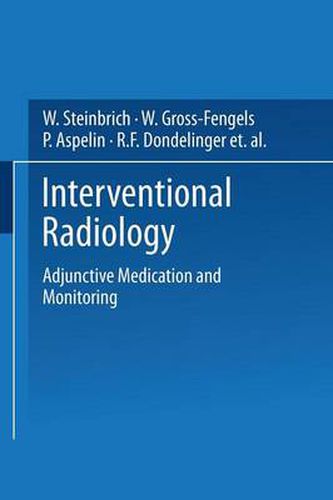Readings Newsletter
Become a Readings Member to make your shopping experience even easier.
Sign in or sign up for free!
You’re not far away from qualifying for FREE standard shipping within Australia
You’ve qualified for FREE standard shipping within Australia
The cart is loading…






This title is printed to order. This book may have been self-published. If so, we cannot guarantee the quality of the content. In the main most books will have gone through the editing process however some may not. We therefore suggest that you be aware of this before ordering this book. If in doubt check either the author or publisher’s details as we are unable to accept any returns unless they are faulty. Please contact us if you have any questions.
Over the years, interventional radiology has developed many effective and less invasive procedures. As the number and types of interven tions increase, radiologists are becoming more and more involved in clinical patient care. This includes pre-interventional patient workup, sophisticated medical therapy and monitoring during interventions, regular inpatient rounds and complete follow-up management. Therefore interventional radiologists are faced with a broad spectrum of clinical and pharmacological questions. Adjunctive medical therapy should increase the patient’s comfort, should improve the success rates, and should further reduce the risks of the procedures. In order to fulfill our responsibility to the patients, a profound knowledge of certain drugs is indispensable. This in cludes, for example, sedatives, analgesics, cardiovascular drugs and agents to prevent infections, thromboembolic complications or restenoses. Moreover, a good monitoring system during complex procedures will increase the safety of radiological interventions. These topics and several more have been presented and discussed during an international symposium in Basel, Switzerland, in January 1992. It is the benefit of the authors, that all these results could be published shortly after the event. Connected with our thanks to all the co-workers the editors hope to find this publication assisting an increasing number of safe interventions.
$9.00 standard shipping within Australia
FREE standard shipping within Australia for orders over $100.00
Express & International shipping calculated at checkout
This title is printed to order. This book may have been self-published. If so, we cannot guarantee the quality of the content. In the main most books will have gone through the editing process however some may not. We therefore suggest that you be aware of this before ordering this book. If in doubt check either the author or publisher’s details as we are unable to accept any returns unless they are faulty. Please contact us if you have any questions.
Over the years, interventional radiology has developed many effective and less invasive procedures. As the number and types of interven tions increase, radiologists are becoming more and more involved in clinical patient care. This includes pre-interventional patient workup, sophisticated medical therapy and monitoring during interventions, regular inpatient rounds and complete follow-up management. Therefore interventional radiologists are faced with a broad spectrum of clinical and pharmacological questions. Adjunctive medical therapy should increase the patient’s comfort, should improve the success rates, and should further reduce the risks of the procedures. In order to fulfill our responsibility to the patients, a profound knowledge of certain drugs is indispensable. This in cludes, for example, sedatives, analgesics, cardiovascular drugs and agents to prevent infections, thromboembolic complications or restenoses. Moreover, a good monitoring system during complex procedures will increase the safety of radiological interventions. These topics and several more have been presented and discussed during an international symposium in Basel, Switzerland, in January 1992. It is the benefit of the authors, that all these results could be published shortly after the event. Connected with our thanks to all the co-workers the editors hope to find this publication assisting an increasing number of safe interventions.